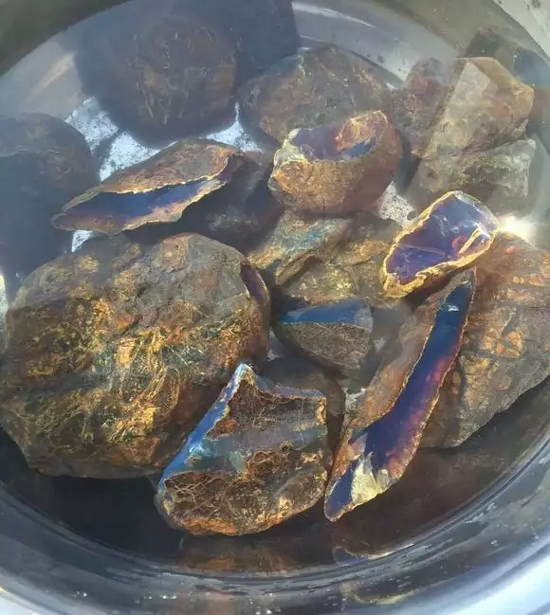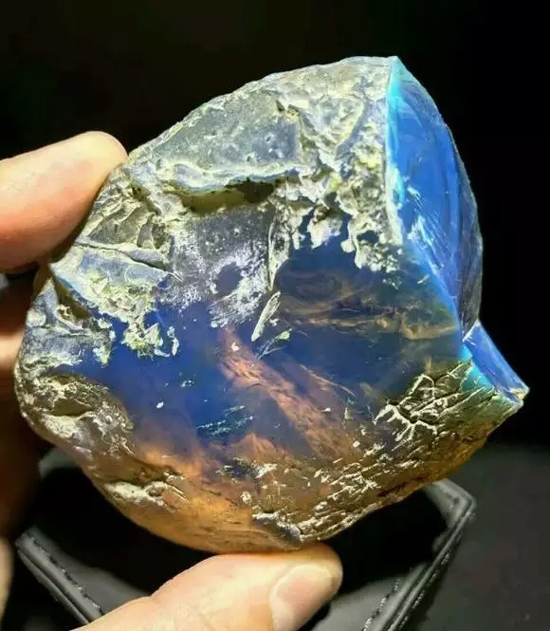Lanpo is known as the king of amber, the two most familiar Lanpo are Dominican Blue Perot and Mexican Blue Perth. Among them, Doppler's unique Lanpo is the rarest and the most expensive! Dominica is the meaning of "Sunday" in Spanish. It was discovered by Columbus on duty during the late fifteenth century. It was named after it was found on Sunday. The formation of Lanpo Lanper is considered a national treasure by the Dominican Republic of Central America. It comes from the leguminous plant resin 30 million years ago. Its special blue causes are widely discussed. It is widely recognized by the scientific community that the amber is heated by the volcanic lava flowing through the surface. Lanper was originally a common amber in the formation. It was the high temperature of the Dominican volcano erupted thousands of years ago, causing pyrolysis of the buried amber in the formation, and the fluorescent substance produced during the pyrolysis process, the polycyclic aromatic molecule, was incorporated into the amber. Among them, this is the core of the formation of the mysterious color of the blue. It can be seen that the unique geological conditions of Dominica at the time can contribute to the formation of Lanpo, which is why it is only produced in the country. Dominica is a volcanic island with a population of only 48,000 square kilometers and a population of less than 10 million. The island is covered by 65% ​​of the tree species. Due to the special volcanic islands, the tree species on the island changed rapidly in the historical changes, and the tree species were relatively small. The blocks of Lanpo were found to be relatively small, and the reasons for the formation of Lanpo could not be scientifically explained so far. However, two of them are most likely. One is that the volcanic ash from the volcanic eruption falls on the flowing resin, and the other is the resin formation of a unique legume. I think the reason why these two may be close is because Lan Po's loose scent is different from other varieties of amber when performing thermal experiments or punching. This proves that Lanpo is not a conifer. Resin, definitely other tree species. Lanper's coloring characteristics On the whole, Lanpo's body color is pale yellow, and the surface of the light is blue. This blue color is more obvious under the sun or dark background, and the blue color changes with the angle of illumination of the light. Flexible movement. The finest blue pel (sky blue) is yellowish and pure under natural light on a white background. The eye feels a slight blue reaction when changing angles, and a strong sky blue appears under dark background and natural light. Under the purple light, there will be a strong blue fluorescence (most of the mines will have such a situation, it is not an important basis for judging whether it is blue or not). The rating of Lanpo is based on the color and the amount of impurities. The less the impurities, the more the blue chromaticity tends to be the best for sky blue. The main market grading now is: 3A (net blue, sky blue), 3A- (net blue, slightly impurity, volcanic ash), 2A (lake blue, with impurities), 2A- (blue-green, with impurities). If the naked eye sees a green-reacting body under natural light, it is generally called blue-green, or green-green. 1. Why does amber look blue and blue? 2. Why does amber emit unusual blue light? 3. Why is this strange blue singer only appearing on the small island country of Dominican Republic? These three questions are believed to be the common doubts of all those who have seen the "Lan Po". Here, let you step by step to uncover the secrets hidden in this mysterious color-changing amber: To test the most direct and effective identification method of Lanpo, the amber is placed under ultraviolet UV light, and the long-wave ultraviolet light with a wavelength of 380-450 nm is used to check whether the amber will have a strong white-blue Milky Blue fluorescence reaction. Some colors look like It is the same as the general orange-yellow amber, which is also used to verify the body. This method directly points to the core of the mysterious color of the blue pel: because this amber contains a special substance "poly-nuclear aromatic molecules" - Anthracene, a "light-sensitive substance" hidden in the blue pel, After being excited by the specific "incident light" of the outside world, the absorbed light can release the fluorescent light that belongs to the visible range (note: that is, the blue, green or violet light we see with the naked eye.) The principle is similar to that of the plasma TV PDP (ie, the old-fashioned color TV, not the current flat-panel LCD TV), which uses a discharge to excite a color phosphor and then produces a variety of colorful visible light. Therefore, the color of Lanpo appears, in fact, a "fluorescent reaction" in physics. Since this is a color reaction of the blue fluorescent material inside the blue, and this fluorescent material is not evenly distributed in every corner of the amber, the reaction of external light will vary with the angle of "injected light". Changes, and the density of the original ore monomer, also showed a large gap, which explains why the color of the blue and white color is different, and some blue is not transparent, and the blue is not transparent. Some are as clear as water. There are more than 500 kinds of minerals with fluorescence in nature, but most of them need to be illuminated by a specific wavelength source. In the dark, the obvious fluorescence reaction can be seen. Lanpo is one of the few that can see the color change of fluorescent color under natural light. . Another question is: How does this substance appear in the Blue Perth? Is there any amber in other areas? First of all, we must first have the concept that polycyclic aromatic hydrocarbons are products of incomplete combustion of carbon-containing compounds. They are widely present in the natural environment in which we live, such as forest fires or volcanic eruptions. Naturally formed hydrocarbons of this type. Both amber and coal are plant-derived “organic fossils†that are often found in the same stratum, and if accompanied by large-scale volcanic eruptions, buried in a large number of hot volcanic ash and lava, make carbon-containing organic compounds such as resins and plants. The pyrolysis effect of incomplete combustion occurs in a high-pressure and high-heat formation environment (smoldering), which contributes to the formation of a large amount of hydrocarbons in amber. The blue amber of Dominican and the normal golden amber are observed by the freshly unearthed rawamber. No matter the appearance or its contents, the appearance of the blue ore is often accompanied by gray-white gravel (volcanic ash). It is strange to form a ridge-like vertical ore body, in which the contents are often dissolved and have obvious flow patterns, and usually the more internal dissolved impurities, the stronger the blue fluorescence reaction under sunlight. These Lanper's distinctive features have led scientists to conclude that the origin of Lanpo is the result of the dissolution and repolymerization of normal amber in the original local layer at high temperatures. The fluorescent material produced during pyrolysis is incorporated into amber. The higher the concentration, the higher the fluorescence response. Strong. Lanper's singular color seems to be illusory, especially the transparent and impurity-free blue sap, which is lemon yellow under normal light. It must be observed under a black background or by a special angle to see the blue fluorescent light, so there is no Do few people have doubts about Lanper's "blue"? I don't even agree to call it "Blue". In fact, I think that the definition of "color" must be examined from a more macro-wider and more scientific perspective. The blue ocean is colorless, and the bright red flowers are also dull in the dark. The so-called "color" is defined by the scientific point of view. It can also be called "visible light". The color seen by the human eye is basically the reflection of visible light, a reflection. The surface of light of all wavelengths is white, and the surface of light that absorbs all wavelengths is black. In fact, the answer is very simple. "Blue has always disappeared." Don't forget that Blue Pop's blue fluorescent light is excited by external light energy. As long as there is UV rays, it exists. The only difference is the change of light around it. The white area reflects all the visible light. The faint fluorescent light is faint and unclear in the dazzling light. It is like a white star, which does not mean that the stars are not there. The black area absorbs all visible light, so the blue fluorescent light is obvious. It also indirectly proves that even in the clear blue water, there is also the presence of fluorescent substances. Regardless of its true cause, the uniqueness of blue amber is that the color is very varied, just like the pigment on the palette is based on blue, which can be blended with light blue, dark blue, sky blue, violet blue, sea blue. More than ten kinds of color changes, such as blue, red, yellow, green and blue, sometimes even three or more different "blue" can be seen in the same blue opal ore. Even a single color of the ordinary Lan Po will show a completely different color change in different light, just like a magical dazzling fascination. The proportion of Lanpo is only 1.05-1.08, which is the lightest gem in the world! Exquisite and light, the touch is warm and beautiful, and the mottled texture faintly tells the thrilling transformation of thousands of years ago. Decorative Duct Tape,Decorative Wall Tape,Decorative Masking Tape,Decorative Sticky Tape Jiangmen M.F.B.S. Machinery Ltd. , https://www.newpowerhk.com

